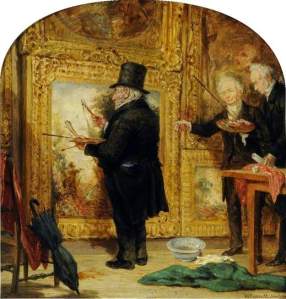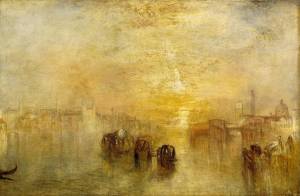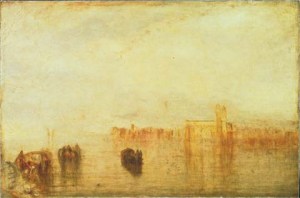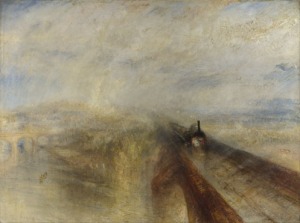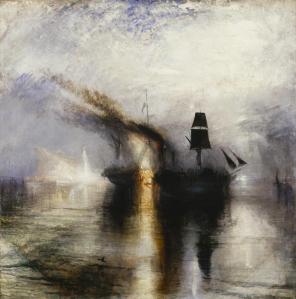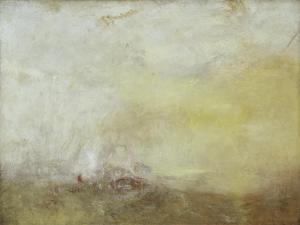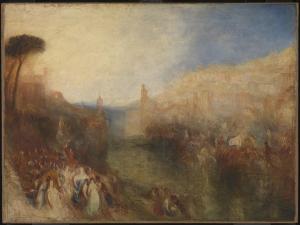Towards the end of last year, I visited Tate Britain’s exhibition of the late works of J.M.W Turner (1775-1851). Its opening in September was closely followed by Mike Leigh’s humanising biopic of Turner’s last years, and thus the autumn of Turner’s life and work has never been in greater focus.
Presenting his work from the period 1835 to 1850, the exhibition attempts to wrest Turner away from recent perceptions of him as a man abstracted from the early Victorian period, who produced inward-looking work that was so outside of its time that it was practically proto-Modernist. On the contrary, this exhibition argues that he was a thoroughly outward looking participant in Victorian life and wholly engaged in the commercial art world of the period. The fact that the exhibition should choose to use his groundedness in the 19th century as proof of his greatness demonstrates just how high the critical stock of the Victorians is right now.
The work shown here represents a response to the early years of Queen Victoria’s reign by an artist who seemed determined to immerse himself in the new, even though his formative perspective came from an earlier and quite different age. During this period, Turner continued to draw on and engage with the past as a theme, but only when it offered lessons or a possible outcome to an often uncertain present. He carefully chose historical or literary-historical subjects for this purpose, and also reworked old canvases, literally re-creating and re-visioning the past into a more contemporary standpoint in, for example, his last Academy shows of 1847 and 1849.
The breadth and quality of work on display also offers a rebuttal to the opinion that his advancing years and declining health caused a commensurate decline in the craftsmanship and appetite of his work. This opinion was voiced as early as the first full-length biography of Turner in 1862, in which Walter Thornbury ruefully designates Turner’s final works as the “dreams, challenges, theories, experiments and absurdities” of an artist who had lost his sense of form and the sharpness of his eye ( The Life of J.M.W. Turner, London, 1862).
With just three weeks left, there’s not much time to catch the show, but if you get a chance to see it, here are my suggestions for the must-see painting in each room.
(For those that can’t get to the exhibition, I’ve included copies of the pictures in my discussion below, with the obvious caveats about the flatness and variable quality of digital reproductions).
Room 1: Turner in 1835
Room 1 takes stock of Turner’s life in 1835, as he turned 60 years old. He was still travelling, still working and still innovating, and as connected to the natural world and his social milieu as he ever was. This in turn produced a body of work that was as prodigious as ever.
Dodge the audio guide zombies for Turner on Varnishing Day, by William Parrott (?c.1840):
While this is obviously a picture of Turner, rather than a picture by him, it gives an impression of the man in this later period of his life, and a sense of how he was viewed by his contemporaries.
Turner enjoyed the conviviality of these varnishing days, commenting that “When we have no varnishing days, we [artists] shall not know one another”, but as the subject of the painting here, he has his back to his audience. Instead of the viewer, he focuses intently on his work, clutching a fistful of brushes as he makes the final touches to one of his works that jostles for position amidst so many other canvases around it.
The details of his dress – a top hat he’s forgotten to remove, a sky blue spotted hanky poking from his pocket and a squat black brolly in the foreground – all suggest a certain eccentricity and an alternative style. Turner is also observed by two of his contemporaries to the right of the frame; one stands poised to complete his own varnishing, but the other looks directly at us and points at Turner working. Is he gesturing in despair at Turner’s selfish monopolisation of the scene, preparing to tap him on the shoulder and move him along, or is he ensuring this lesser artist gives the master Turner the time and space he deserves, while also asking us to look and admire him at work?
Room 2: Turner on the Move
Room 2 belies any notions of Turner’s physical paralysis or stagnation by attending to his extensive and regular European travels during the period 1835 to 1845, especially to Switzerland. He appears as a solitary figure but also an intrepid one, travelling by any means necessary, even if it meant long stretches of walking. This active body was supported by an equally active mind, as evidenced by his constant sketching in the notebooks included on display here.
Seek out the pair of pictures Going to the Ball (San Martino) and Returning from the Ball (St Martha), a pair of pictures which formed his last exhibited work on Venice:
Going to the Ball is dominated by a strong glow of yellow at its core, which radiates out to shroud the promised destination in a haze of golden rays. The dark boats at the centre are poised between this future place and the darker edge of their past from where they have come. More bright and animated guests wait at this embarkation point, dressed in their finery for the party.
This is neatly inverted in Returning from the Ball, in which the bright glow of promise has worn off, and everything is reflected through a much paler colour scheme. The figures are darker, less distinct and huddled more closely together; those bright party hats have gone.
Both paintings attracted critical disapproval and a disappointed rejection by their original sponsors, but for me beautifully capture the excitement of promise of a forthcoming event, and the calmer, more melancholic aftermath.
Room 3: Turner as a man in time
During this period, Turner’s industry was as much mental as physical, and Room 3 shows his more contemplative work of the period. Despite his firm commitment to a contemporary viewpoint, as mentioned above, he drew on the past for ideas. His sources included literary works (the Bible and Shakespeare’s plays), historical events or myths, but also the footprints of the past that he found in the landscape and architecture of places such as present day Italy and France. He also reflected on new technologies of the time, and their impact on they way we live now.
Make the time for Rain, Steam and Speed – the Great Western Railway:
In a scene that presages the Lumiere’s early film The Arrival of a Train at La Ciotat Station (1895), the locomotive here seems to be speeding directly out of the canvas towards the spectator.
Turner has returned to a location he had painted before the coming of the railway, and was attracted by its particular serenity, but here, he presents an account of the interruption of the time-bound and man-made into the seemingly time-less and natural.
For such a modern subject, he needed a modern technique – how could he capture the idea of the speed of the train, and the rain through which it sped? Following the Morning Chronicle’s description of this as “probably the most insane and most magnificent of all these prodigious compositions” (8 May 1844), W.M. Thackeray in Fraser’s Magazine wondered admiringly at Turner’s techniques: “The rain … is composed of dabs of dirty putty slapped on to the canvas with a trowel […] although the fire in the steam engine looks as if it were red I am not prepared to say it is not painted with cobalt and pea-green” (June 1844).
One might compare this response to technology to Charles Dickens’s description of the railway’s deforming and destructive powers in Dombey and Son, which began serialisation 2 years later, and in which the train is “the monster, Death”, a “fiery devil, thundering along so smoothly, tracked through the distant valley by a glare of light and lurid smoke, and gone!”.
Room 4: Experimenting with Form
Room 4, billed as an ‘exhibition within an exhibition’ presents some of Turner’s from 1840-46, which were painted within a square support and demonstrate Turner’s continued willingness to innovate and experiment with the form and medium that might carry his work.
Bear with the crowds for Peace: Burial at Sea, in which Turner depicts the sea burial of fellow Academician Sir David Wilkie, just off Gibraltar:
A related picture by their mutual friend George Jones takes its viewpoint from the boat itself, but here Turner places the entire cortege (including a traditional funeral carriage onboard) in the centre of his picture, with black predominating the scene.
Although the distance of the boat precludes any close detail of the burial, Turner’s painting is nonetheless symbolically dense. There is the obvious contrast between the heavily-worked darkness of ‘Earth’, including the sea (the destination of Wilkie’s body) and the less worked but brighter, ethereal sky (the destination of Wilkie’s soul). A further contrast is effected through the calm sea appropriate to the last rites, and the clear signs of industry and movement, the bright orange and smoke of the ship’s engines.
The boat also casts a long shadow, much as the loss of the great painter will, and the bird in the lower left suggests even Nature may be mourning in traditionally symbolic fashion.
Room 5: Late Sea Paintings
It seems that Turner’s interest and work on the sea actually intensified in his later years, as he still valued the sea as a place of calm and contemplation, but also a site of potentially great drama – for example, in whaling expeditions.
Pause to ponder over Sunrise with Sea Monsters:
This is a thoroughly puzzling picture, which, like all great paintings, asks you to think carefully about what you are looking at. The title, given to the painting by the curators who first ‘discovered’ it rather than by Turner himself, is indicative of its confusing nature. In a scene composed of so much sky, it is the two small creatures circling the darker whirlpool that have characterised our response to it; in a single canvas, it holds both the conventional ‘Turneresque’ calm, gentle pastoral subject but also the suggestion of something darker and more disturbing. Turner regularly painted scenes from whaling expeditions, but this picture has not been judged as part of this group; its subject, and its treatment, are felt to be so aberrant, mutated or uncomposed that it has been pushed towards the category of a monstrosity.
What is it that Turner really saw on this misty morning? And more to the point, what is it that those curators saw, that led them to an interpretation imbued by ideas of myth and legend? Like Parrott’s painting, this picture tells us as much about how Turner was viewed as it does about Turner himself.
Room 6: Speculative
Turner worked intermittently from 1846 to his final exhibition in 1850, and the selection in Room 6 shows some of his final completed Swiss watercolours and a number of unfinished oil paintings that have no clear sense of Turner’s final expectations. They are often untitled and/or undated and tantalisingly present shapes and forms in an embryonic or evolving state; here we have, then, another whole room of early beginnings in a room marking an ending, of the exhibition and Turner’s life.
Pause before the Exit for The Departure of the Fleet:
This picture was included in Turner’s last RA show in 1850, and is a final return to the idea of past history as a tutor for the present, depicting a scene from the decline of the Carthaginian Empire. Despite his enthusiastic immersion in his own times, then, Turner could still provide a valedictory warning to his own time on the mutability of power. We’re not quite in deathbed speech territory (or waters) here, but this painting nonetheless offers the confident, progressive march of Victorian Britain a pause for thought.
Moreover, as the last picture in the exhibition, it is the final, lingering visual impression of Turner’s last years that neatly dovetails with Cosmo Monkhouse’s verbal coda:
[Turner] appears to us in these last days like a great ship, rudderless, but still grand and will all sails set, at the mercy of the wind, which played with it a little while and then cast it on the rocks.
This exhibition’s navigation through the final imaginative voyages of Turner’s great ship is well worth embarking on.
“Late Turner: Painting Set Free” runs until January 25th 2015.

